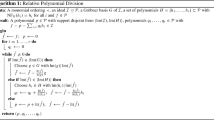Abstract
Using Buchberger's Gröbner basis theory, we obtain explicit algorithms for computing Stanley decompositions, Rees decompositions and Hironaka decompositions of commutative Noetherian rings. These decompositions are of considerable importance in combinatorics, in particular in the theory of Cohen-Macaulay complexes. We discuss several applications of our methods, including a new algorithm for finding primary and secondary invariants of finite group actions on polynomial rings.
Similar content being viewed by others
References
K. Baclawski: Rings with lexicographic straightening law,Advances in Math. 39 (1981), 185–213.
K. Baclawski, andA.M. Garsia: Combinatorial decompositions of rings,Advances in Math. 39 (1981), 155–184.
D. Bayer: The division algorithm and the Hilbert scheme, Ph.D. Dissertation, Harvard University, 1982.
D. Bayer, andM. Stillman: The design of MACAULAY: A system for computing in algebraic geometry and commutative algebra,Proceedings of ACM SYMSAC, 1986.
L. J. Billera: Homology of smooth splines: Generic triangulations and a conjecture of Strang,Trans. Amer. Math. Soc. 310 (1988), 325–340.
L.J. Billera, R. Cushman andJ.A. Sanders: The Stanley decomposition of the harmonic oscillator,Proc. Koninklijke Nederlandse Akademie van Wetenschappen,A 91 (1988), 375–393.
B. Buchberger: Ein algorithmisches Kriterium für die Lösbarkeit eines algebraischen Gleichungssystems,Aequationes Mathematicae,4 (1970), 374–383.
B. Buchberger: Gröbner bases-an algorithmic method in polynomial ideal theory, Chapter 6 in N.K. Bose (ed.):“Multidimensional Systems Theory”, D. Reidel Publ. Comp., 1985.
B. Buchberger: Applications of Gröbner bases in non-linear computational geometry, in J.R. Rice (ed.):Scientific Software, I.M.A. Volumes in Mathematics and its Applications, # 14, Springer, New York, 1988.
R. Cushman andJ.A. Sanders: A survey of invariant theory applied to normal forms of vectorfields with nilpotent linear part, in D. Stanton (ed.):“Invariant Theory and Tableaux”, I.M.A. Volumes in Mathematics and its Applications,19, Springer, New York, 1990, pp. 82–106.
R. Cushman, J.A. Sanders, N. White: Normal form for the (2;n)-nilpotent vectorfield, using invariant theory,Physica D 30 (1988), 399–412.
C. De Concini, D. Eisenbud andC. Procesi: Hodge algebras, Astérique91 (1982).
J.A. Dieudonné andJ.B. Carrell:Invariant Theory-Old and New, Academic Press, New York, 1971.
P. Doubilet, J.P.S. Kung, andG.C. Rota: Invariant theory, Young bitableaux, and combinatorics,Advances in Math. 27 (1978), 63–92.
D. Eisenbud: Introduction to algebras with straightening laws, in B.R. McDonald (ed.):Ring Theory and Algebra, Proceedings of the third Oklahoma conference, Marcel Dekker, New York, 1980.
A. Garsia: Combinatorial methods in the theory of Cohen-Macaulay rings,Advances in Math. 38 (1980), 299–266.
T. Hibi: Every affine graded ring has a Hodge algebra structure,Rend. Sem. Mat. Univer. Politecn. Torino 44 (1986), 277–286.
D. Hilbert: Über die Theorie der algebraischen Formen,Math. Annalen 36 (1890), 473–534.
M. Hochster andJ. Roberts: Rings of invariants of reductive groups acting on regular rings are Cohen-Macaulay,Advances in Math. 13 (1974), 115–175.
M. Hochster andJ.A. Eagon: Cohen-Macaulay rings, invariant theory, and the generic perfection of determinanatal loci,American J. Math. 93 (1971), 1020–1058.
W.C. Huffman andN.J.A. Sloane: Most primitive groups have messy invariants,Advances in Mathematics 32 (1979), 118–127.
G. Kempf: The Hochster-Roberts theorem of invariant theory,Michigan Math. J. 26 (1979), 19–32.
G. Kempf: Computing invariants, in S.S. Koh (ed.):Invariant Theory, Springer Lecture Notes # 1278, Heidelberg, 1987.
B. Kind andP. Kleinschmidt: Schälbare Cohen-Macaulay-Komplexe und ihre Parametrisierung,Math. Zeitschrift 167 (1979), 173–179.
J.P.S. Kung andG.-C. Rota: The invariant theory of binary forms,Bull. American Math. Soc. 10 (1984), 27–85.
E. Noether: Der Endlichkeitssatz der Invarianten endlicher Gruppen,Math. Annalen 77 (1916), 89–92.
D. Rees: A basis theorem for polynomial rings,Cambridge Phil. Soc. Proc. 52 (1956), 12–16.
D. Shannon andM. Sweedler: Using Gröbner bases to determine subalgebra membership, split surjective algebra homomorphisms, and birational equivalence,J. Symbolic Computation 6 (1988), 267–273.
N.J.A. Sloane: Error-correcting codes and invariant theory: New applications of a nineteenth-century technique,American Math. Monthly 84 (1977), 82–107.
R.P. Stanley: Invariants of finite groups and their applications to combinatorics,Bulletin Amer. Math. Soc. 1 (1979), 475–511.
R.P. Stanley: Linear diophantine equations and local cohomology,Inventiones math. 68 (1982) 175–193.
R.P. Stanley: Hilbert functions of graded algebras,Advances in Math. 28 (1978), 57–83.
R. P. Stanley:Combinatorics and Commutative Algebra, Birkhäuser, Boston, 1983.
B. Sturmfels: Computing final polynomials and final syzygies using Buchberger's Gröbner bases method,Resultate der Mathematik,15 (1989), 351–360.
B. Sturmfels andN. White: Gröbner bases and invariant theory,Advances in Math.,76 (1989), 245–259.
W. Whiteley andN. White: The algebraic geometry of stresses in frameworks,SIAM J. Alg. Discr. Meth. 4 (1983), 481–511.
Author information
Authors and Affiliations
Additional information
Research supported by the Institute for Mathematics and its Applications, Minneapolis, with funds provided by the National Science Foundation




